| Article ID | Journal | Published Year | Pages | File Type |
|---|---|---|---|---|
| 3170640 | Orthodontic Waves | 2006 | 7 Pages |
The aim of this study was to clarify the influence of masticatory function on dental arch forms. We evaluated the relationship between the masticatory movement path and occlusal force (as masticatory function) and the dental arch width and first molar bucco-lingual inclination. The subjects were 60 healthy adult females (mean 23.4 years; S.D. 1.6 years) without previous orthodontic treatment or functional abnormalities in the temporomandibular joint. Furthermore, the subjects were divided into a wide group (W-group) and a narrow group (N-group) based on mean maxillary inter-molar width in Japanese females. The masticatory path was recorded using gnathohexagraph system. Maximum occlusal force was measured using a simple type occlusal force meter. And subjects’ arch width and bucco-lingual inclination of the first molars was measured. W-group showed larger arch width and the first molar was more upright on the buccal side compared with N-group. Furthermore, the lateral component of masticatory movement and maximum occlusal force was large in W-group compared with N-group. In the group which strong occlusal force and grinding type mastication had wide arch width and the mandibular first molars upright on the buccal side.
